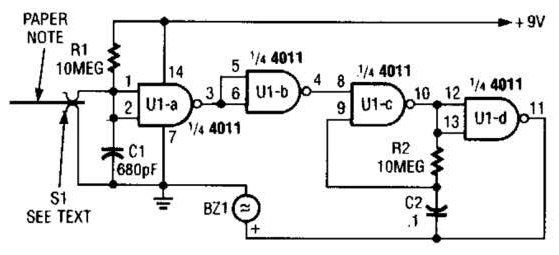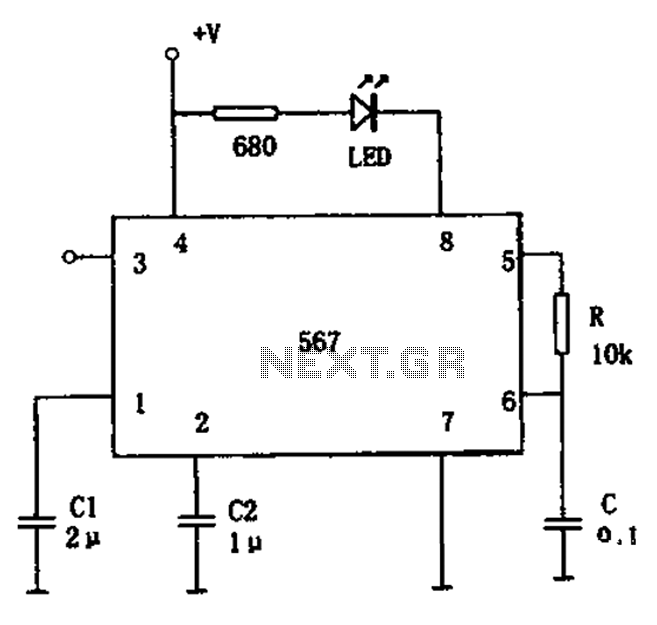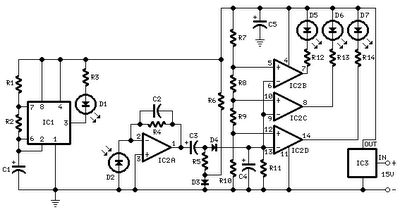
Audio Memo Alert Circuit

This device prevents paper notes and memos from being overlooked. A paper note placed between two fingers made of a conducting material (metal or conductive plastic) breaks the circuit, allowing pair 1 of Ul-a to go high. The goal is to transmit more information by carrying articles. Please send an email to [email protected] within 15 days if there are issues regarding article content, copyright, or other concerns. It will be deleted soon.
The described device functions as a reminder system that utilizes a simple circuit to detect the presence of paper notes or memos. The core mechanism involves two conductive fingers, which can be made from materials such as metal or conductive plastic. When a paper note is introduced between these fingers, it disrupts the electrical circuit, triggering a response in the system.
The circuit operates with a pair of terminals, designated as Ul-a, which are in a low state when the circuit is closed. When a note is inserted, the physical separation caused by the note leads to an interruption in the circuit, which causes the output of Ul-a to switch to a high state. This change can be used to activate various outputs, such as visual indicators (LEDs), audible alarms, or even notifications to a connected system.
The device aims to enhance information transmission by allowing users to carry articles or notes that can be easily detected and acknowledged by the system. This can be particularly useful in environments where reminders or notifications are crucial, such as in offices or educational settings.
For any inquiries related to the content of the articles, copyright issues, or other concerns, users are encouraged to reach out via the provided email address. It is important to address these matters promptly, as there is a specified timeframe for resolution.This device prevents paper notes and memos from being overlooked. A paper note placed between two fingers made of a conducting material (metal or conductive plastic) breaks the circuit, allowing pair 1 of Ul-a to go high. We aim to transmit more information by carrying articles. Please send us an E-mail to wanghuali@hqew. net within 15 days if we a re involved in the problems of article content, copyright or other problems. We will delete it soon. 🔗 External reference
The described device functions as a reminder system that utilizes a simple circuit to detect the presence of paper notes or memos. The core mechanism involves two conductive fingers, which can be made from materials such as metal or conductive plastic. When a paper note is introduced between these fingers, it disrupts the electrical circuit, triggering a response in the system.
The circuit operates with a pair of terminals, designated as Ul-a, which are in a low state when the circuit is closed. When a note is inserted, the physical separation caused by the note leads to an interruption in the circuit, which causes the output of Ul-a to switch to a high state. This change can be used to activate various outputs, such as visual indicators (LEDs), audible alarms, or even notifications to a connected system.
The device aims to enhance information transmission by allowing users to carry articles or notes that can be easily detected and acknowledged by the system. This can be particularly useful in environments where reminders or notifications are crucial, such as in offices or educational settings.
For any inquiries related to the content of the articles, copyright issues, or other concerns, users are encouraged to reach out via the provided email address. It is important to address these matters promptly, as there is a specified timeframe for resolution.This device prevents paper notes and memos from being overlooked. A paper note placed between two fingers made of a conducting material (metal or conductive plastic) breaks the circuit, allowing pair 1 of Ul-a to go high. We aim to transmit more information by carrying articles. Please send us an E-mail to wanghuali@hqew. net within 15 days if we a re involved in the problems of article content, copyright or other problems. We will delete it soon. 🔗 External reference





